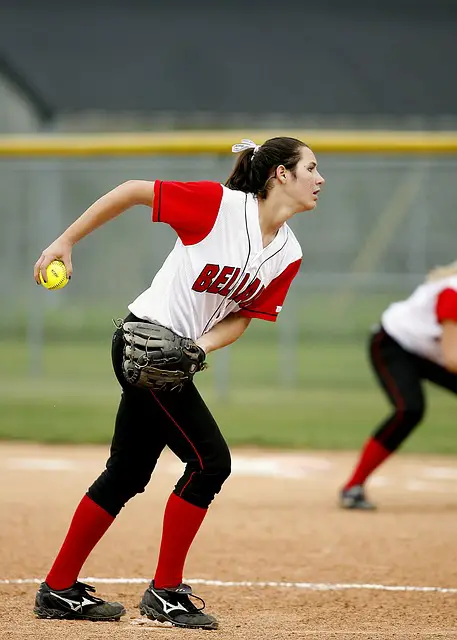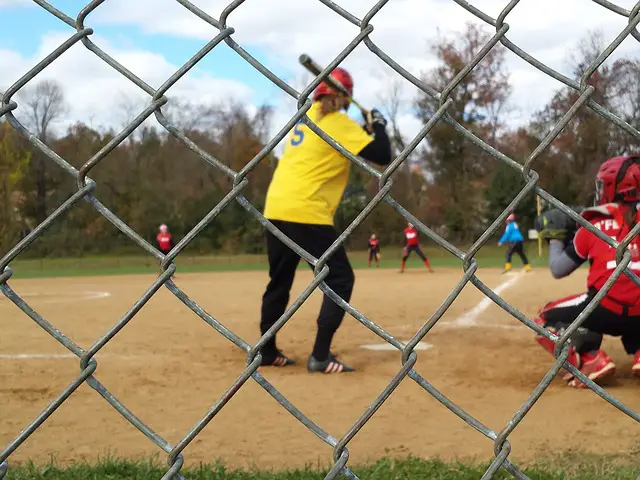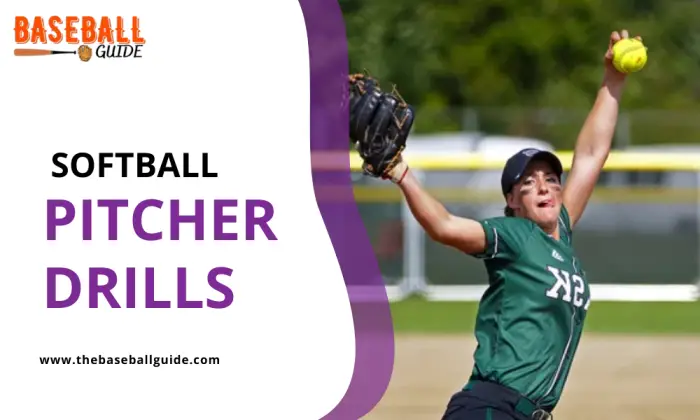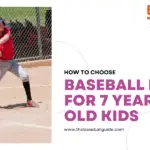Invented in Chicago, in 1887, softball is a bat and ball game similar to that of baseball. The ball is larger in softball, bats are thinner and longer, and the field is smaller in dimensions. The most obvious difference between the two is pitching.
When you are practicing pitching drills for softball, you should understand what needs to be done differently from the standard baseball pitching drills.
In this article, you will find the best pitching drills for youth softball that will help you deliver the perfect pitch.
Best Softball Pitching Drills for Beginners
For beginners looking to improve their softball pitching skills, there are a variety of drills that can help. Some of the best softball pitching drills for beginners include the wrist snap drill, the towel drill, and the stride and separation drill. These drills focus on proper technique, mechanics, and control, helping beginners develop a strong foundation for their pitching abilities.
Pitching Drill | Benefits | Equipment Needed | Skill Level | Difficulty Level |
One Knee Drill | Improves arm strength, accuracy, and mechanics | Softball, Glove | Beginner/Intermediate | |
Shadow Drill | Develops muscle memory and improves balance and mechanics | None | Beginner/Intermediate | |
Wrist Snap Drill | Improves spin and movement on pitches | Softball, Glove | Intermediate/Advanced | |
Power Stride Drill | Improves power and velocity on pitches | Softball, Glove | Intermediate/Advanced | |
Change-Up Drill | Improves deception and pitch variety | Softball, Glove | Intermediate/Advanced | |
Bullpen Drill | Develops control, consistency, and mental toughness | Softball, Glove, Catcher | Intermediate/Advanced | |
Four-Corners Drill | Improves accuracy and command of different pitch locations | Softball, Glove, Targets | Intermediate/Advanced | |
Pitching Wedge Drill | Develops accuracy and command of high pitches | Softball, Glove, Pitching Wedge | Intermediate/Advanced | |
King of the Hill Drill | Develops mental toughness, competitiveness, and situational awareness | Softball, Glove, Catcher | Advanced | |
Pitching Machine Drill | Improves timing, pitch recognition, and swing mechanics | Softball, Batting Helmet, Bat, Pitching Machine | Beginner/Intermediate/Advanced |
Pitching Drills for Softball

Only with the right coaching that the youth can play up to their full potential. Therefore, youth softball players must practice the right pitcher drills. Since the pitching techniques used are different, choosing the right softball pitching drill can be very confusing.
Given below are some of the best softball-pitching drills for beginners as well as for mature players. These drills will not only help the youth players have the right softball pitching training but will also help seasoned and strong players gain more confidence in the game.
Arm Swing Drill
In softball, the serves are made through underarm tosses. So, to deliver the perfect strikes, the players must know how to swing their arms right. This particular drill focuses just on that and gives the players enough practice to swing their arms directly.
This exercise for softball pitchers requires a solid wall and tennis balls instead of the actual softballs. You can eventually practice with the softballs too, but the objective here is to improve the arm swing. The best part is that players can practice this drill even indoors.
The drill begins with the pitcher standing as close to the wall as possible, while still being able to swing a full arm without hitting the wall. Then the pitcher should perform a full swing serve towards the wall.
After each serve, move a small step away from the wall. Keep moving further away, and performing full-swing serves until you reach the “breaking point.”
The breaking point should be the distance from where the player isn’t able to perform a full swing serve to the wall. This drill relaxes the shoulder muscles and allows the players to get used to swinging their arms.
With eventual practice, the player should be able to pass the breaking point, improving their serve distance and skill.
Another variation of this drill focuses on improving the aim of the pitcher. Just add targets on the wall for players to focus on while serving. You can mark the targets according to the type of service.
For instance, the best areas to serve fastballs are the corners. So illustrating the box on the wall with holes marked as fastballs can improve the serving aim.
Rotation Speed Drill
To deliver throws with more power and momentum, softball players should be able to swing their arms at a faster pace. A rotation speed drill is meant just for that.
This drill not only increases the velocity of the throw but also improves control. If you want to improve the pitches in a short time, then a rotation speed drill for softball pitching is the right practice.
To perform this drill, the player should have the legs positioned wider than the shoulder’s length and in a stride position. It should look like the player has just taken a small stride.
Now in this position, the player should rotate the pitching arm three times and then throw the ball to the catcher in the third rotation.
While doing this drill, it is essential to keep the shoulders relaxed and in control. Remember, the main objective is to improve the player’s rotation speed and ball control.
With more practice, the player should be able to pitch with more significant momentum and should also be able to control the speed of the ball.
It is also important that the player keeps the glove arm at shoulder height in order to aim better. Once the player gets the hang of three rotations, reduce the drill to two rotations and finally to just one rotation.
This drill is one of the best fastpitch pitching drills and can significantly improve the player’s pitching in fastpitch softball games.
Also, if the players feel any type of shoulder pain, it is best not to continue to exercise. Resting is vital during this drill, and any shoulder injury should be immediately attended to. For best results, do these drills not more than two to three days a week.
Dummy Batter Drill
This drill includes a dummy batter or a fake batter. You can use anything as your fake batter. For instance, a cardboard cut-out, or dummy made of wood and clothes, or anything that works well for you. The goal here is for the pitcher to imagine an actual batter in the first-hitting position.
Once the dummy batter is set, draw a line from the center of the hitting area to the center of the pitching mound.
This line should be drawn thick to prevent it from getting blown away by the wind and so that it is clearly visible to the pitcher. Now, when the pitcher serves, the goal should be to serve as close to the line as possible.
The dummy batter drill is probably the best fastpitch drill for beginners. Having a dummy batter stimulates a real game environment. Hence it is also a perfect opportunity for pitchers to try out new things.
Moreover, the dummy batter drill also helps in measuring the skills of the pitcher and highlighting the areas that need improvement.
To get maximum results, players should perform a set of 10 -15 serves for each type of softball serve there is. You can start with 10 Rise-balls, followed by 10 Change-ups, and then followed by 10 Fastballs, and so on.
Beginners can start with a small number of serves and then increase the number and varieties with more practice.
This softball pitching training helps in every way. There can be many variations to this drill. If properly utilized, with the help of this drill, pitchers can focus on line, length, power, accuracy, spin, and a lot more.
20-4 Drill
If you are wondering how to improve the softball pitching accuracy, then a 20-4 drill is the best pitching workout that focuses immensely on the pitcher’s skill.
It is one of the top softball pitching drills of 2023 and is a widely used exercise to improve pitching accuracy.
The 20-4 drill or 10-3 drill, if you are working with youth players, is a very popular stamina and accuracy-building softball pitching exercise.
The basic concept of the training is to throw 20 strikes before the pitcher gets 4 balls. Reduce this number to 10 hits and 4 balls when practicing with youth players.
The pitcher should ideally start this drill for a reasonable pitching distance. However, it is entirely okay to start from a little closer distance, depending on the player’s talent and skill. The player should aim to get 20 strikes before getting 4 balls. Start over if the pitcher gets 4 balls before getting 20 hits.
The 20-4 drill is one of the best softball pitching drills for accuracy. However, it is also essential to understand that this is a repetitive drill, and overstraining the players is not recommended.
Coaches and supervisors should make sure that the players are getting enough rest and that there is no pain.
The main advantage of this drill is that it allows players to focus on accuracy instead of speed and power. Since this is a repetitive drill, it is recommended that players use only 60% of their throwing power while serving.
Using full potential right off the start will exhaust the player and risk shoulder damage.
One Leg Explosion
Probably suitable for experienced fastpitch softball players, One Leg Explosion is a drill that focuses on improving the player’s body posture and increasing the pitching speed.
The main objective of this drill is to enhance the power and speed at which the ball is served while still keeping the body balanced and ready to field.
Start the drill by balancing the body with the stride leg up, explode out as far as possible with the other leg, and finish serving the pitch on the right balance.
Players should focus on the leg drive and distance of the stride. Also, after the player has taken the pace, she should hold for 3 seconds before releasing the ball.
Focusing on the drive and stride distance is very important, but at the end of the stride, the pitcher should be able to balance her body.
Therefore, holding the ball for 3 seconds before releasing is crucial. This will not only improve the body balance but will also help the pitcher improve body control and stride distance.
One leg explosion is one of the best pitching drills for fast-pitch softball. Make sure to practice the drill at least 3 sets of 10 pitches.
Rest enough after each game, but don’t let the body cool down. Eventually, the pitching stamina of the player will also improve.
Benefits of Softball Pitching Drills
In many cases, even after continuous effort, softball pitchers do not show any improvement. Even if the pitchers are throwing about 100 practice serves daily, it doesn’t necessarily mean they will improve.
This is mainly because every individual player has her own skill and development attributes. Blindly forcing them to practice will not yield any results.
Moreover, there is a matter of player fatigue. Throwing about 100 full-speed pitches daily will put high stress on their mind and body, especially on their elbow, knee, and shoulders.
A full-speed softball pitch is about 55mph fast, and throwing such pitches continuously can also lead to overuse injury.
Therefore, softball pitching drills play an essential role in the player’s softball practice. Doing the right practice exercise will help develop players’ strong points and grow the player’s interest.
Softball practices should not be a stress on any player, both physically and mentally. Both the players, as well as coaches, must understand this.
The main benefit of softball pitching drills is that they can focus on improving a specific attribute of the player. For instance, if a pitcher has good throwing mechanics, then particular exercises can be designed for her to improve her aim.
Also, if a pitcher has good aim and body control but lacks power, then a power drill such as “One Leg Explosion” can be used.
However, the key is to understand which softball drill can be most suitable for the player. Suppose the coach makes a player work on some drill that doesn’t improve an attribute, then that may not be the right drill for that player.
This is also the reason why it is considered best to design softball practice drills for beginners that focus on improving the player overall.
Common Mistakes to Avoid in Softball Pitching: Tips for Beginners
Here are some common mistakes to avoid when practicing softball pitching:
- Poor posture: One common mistake that beginners make is not maintaining good posture throughout the pitching motion. This can result in loss of power, control, and an increased risk of injury.
- Incorrect grip: Grip is crucial in softball pitching, and beginners often make the mistake of not holding the ball properly. Make sure to learn and practice the correct grip to avoid mistakes.
- Improper footwork: Footwork is key to delivering a strong and accurate pitch. Make sure to focus on proper footwork and positioning throughout the pitching motion.
- Overexertion: Pitching requires a lot of strength and endurance, but overexerting yourself can lead to injury. Make sure to take breaks when needed and avoid practicing too much too soon.
- Lack of focus: Softball pitching requires focus and concentration. Avoid distractions and stay focused on your technique and form.
- Rushing the motion: Beginners may rush through the pitching motion, resulting in a loss of control and power. Take your time and focus on each aspect of the motion to avoid rushing.
- Ignoring feedback: Feedback from coaches or experienced players can be valuable in improving your pitching technique. Avoid ignoring feedback and instead, use it to improve your skills.
By avoiding these common mistakes, beginners can improve their softball pitching technique and avoid injury. It’s important to remember that practice and consistency are key to success.
Conclusion

The trickiest thing a softball pitcher can face is how to practice and improve the pitches.
There aren’t many drills that guarantee the required results, and they may not be very suitable for softball pitches either.
The softball pitching workouts mentioned above are well-tested and guarantee improvement.
But, keep in mind that to become a good pitcher you also need a good fastpitch softball glove.
However, continuous softball pitching practice can be exhaustive and can damage the player’s shoulders.
Hence, coaches and supervisors need to make sure that the player gets enough rest and is in the best condition before practice every time.



